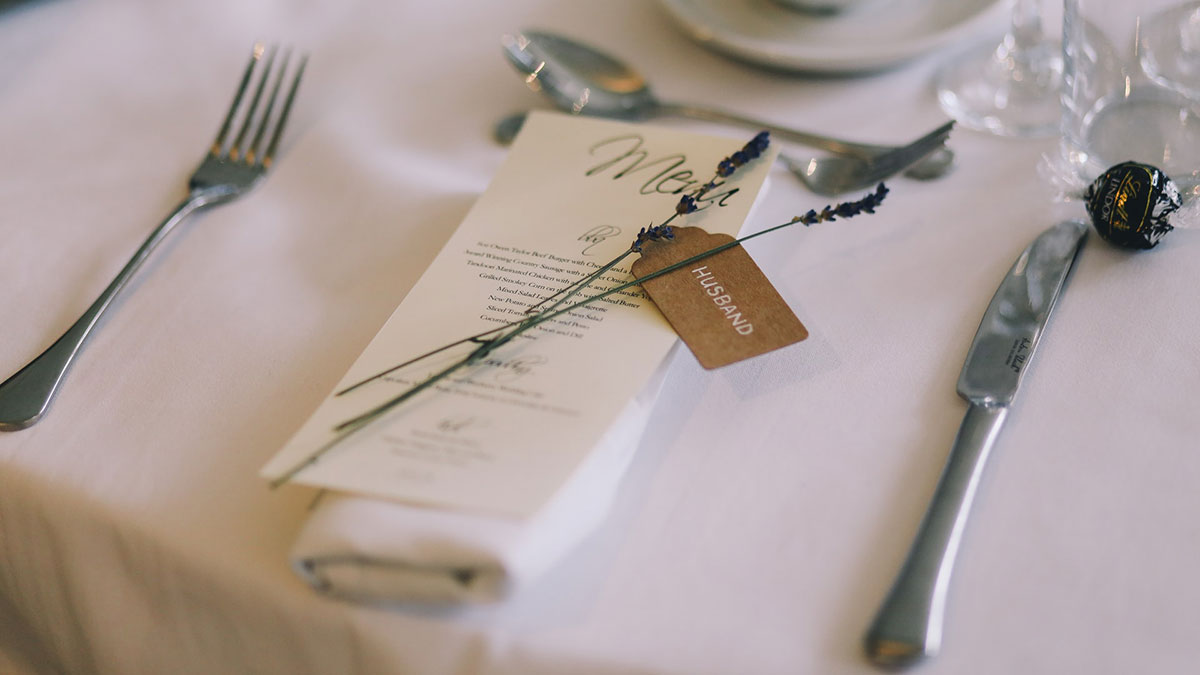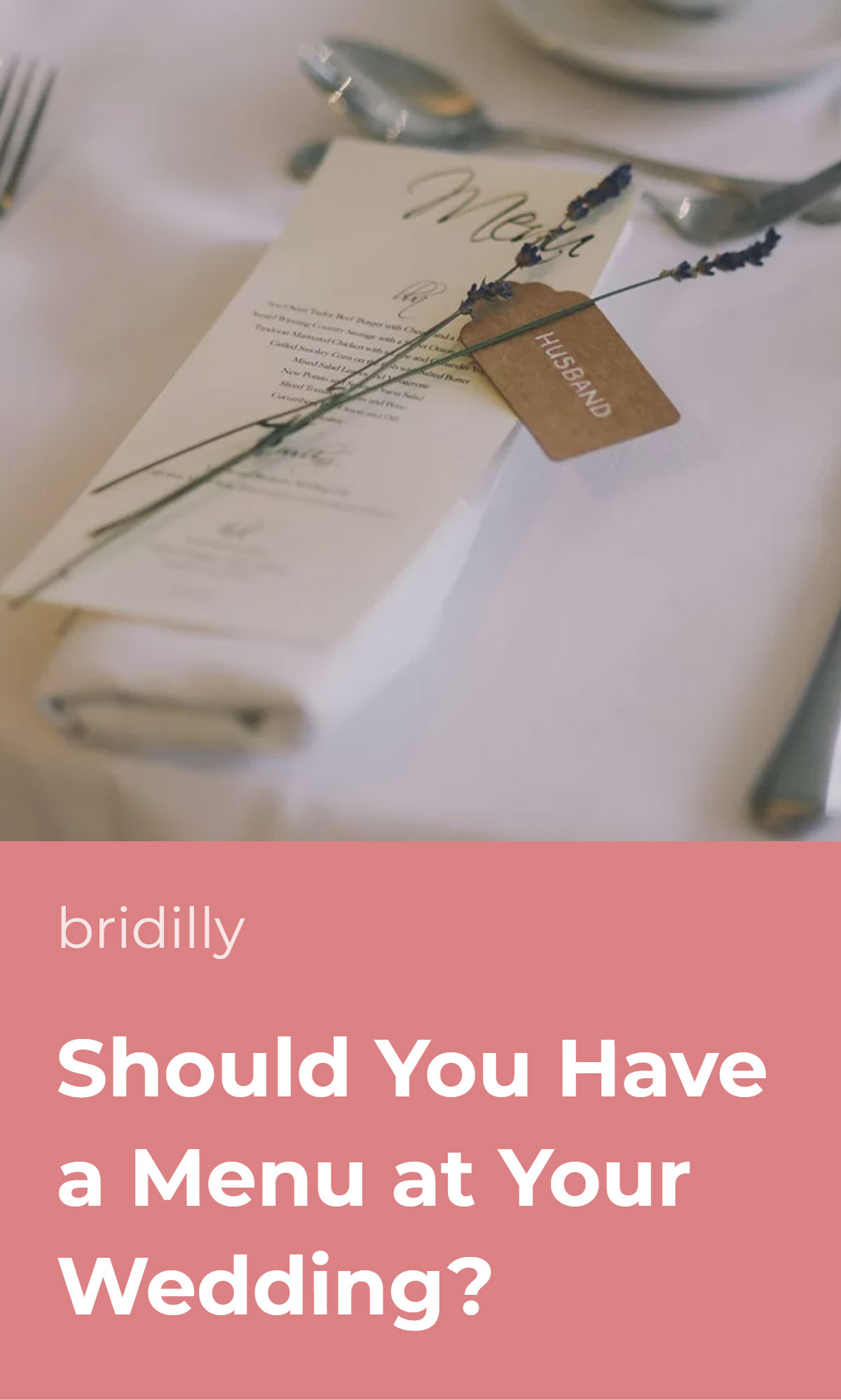A wedding menu may not top the list of event must-haves. Still, the question about menu card importance is valid regardless of your chosen reception type.
Menus are equally beneficial for formal plated dinners and relaxed cocktail-style gatherings.
They add formality to any reception, supporting the elegant atmosphere. Plus, wedding menu cards are another way to express your personality. When designed creatively, such a small detail can create a real wow factor.
The advantages of wedding menus aren’t solely visual. These table pieces are practical in the first place.
Menus provide seated dinner attendees with a selection of foods, as opposed to entrees chosen in advance. They can also cut down the lines at buffet receptions and serve as navigation for food stations.
Wedding menu cards have drawbacks, too. An apparent one is that menus are yet another expense to an already costly event.
You will need to collaborate with a designer to create truly unique and tasteful menu cards. But even if you design the cards yourself, menu printing will add a couple of hundreds of dollars to the total wedding cost.
In the end, it all drains down to your personal preferences and budget. Wedding menus have more pros than cons, yet they aren’t mandatory.
It’s a chic design touch and practical guidance for guests, but the event success isn’t determined by the presence or lack of a menu.
Table of Contents [show]
Formality
Menus are typically offered at plated wedding dinners. However, guests don’t handle the serving themselves at formal seated dinners and must choose meals from limited options.
In this case, a menu is used to list the available dish choices.
Are menu cards the only option for a seated reception? Not at all. You can request guests to include meal choices in their RSVP or serve double entrée.
But a menu makes a wedding dinner truly exquisite, creating a high-end restaurant atmosphere.
A menu can add formality to a family or buffet-style wedding reception, too. It allows you to communicate the food options to guests in an elegant and orderly manner.
Moreover, verbal communication is not only less convenient but also less sophisticated.
Even if you’re hosting a laid-back cocktail-style wedding reception, a menu can add a bit of chic to it. When choosing cocktails from a tastefully designed menu, guests will feel like in a fancy bar.
But if you only offer one type of drink or the guests must ask the bartenders about beverage options themselves, such a reception may seem cheap.
Apart from meal information, a menu can contain a welcome and thank you. It’s a perfect opportunity to thank your guests for their attendance.
Lastly, a menu shows the attention to detail you’ve put into planning the event. A menu that follows the overall wedding style elevates the table decoration to a new level.
Freedom of Choice
This point only relates to plated wedding receptions. Some couples chose a single main course option, not leaving the guests any opportunity to choose.
That’s inconsiderate of their preferences and potential health conditions. Even if you offer two options, for example, vegetarian and fish meals, some guests may not simply like any of them.
Sometimes, couples send out the menu before the wedding, and guests have to submit their dish choices with their RSVP. This creates an illusion of choice.
But in reality, preferences can change over a several-month period. As a result, some guests may not be in the right mood for a meal they chose half a year ago.
A menu offered during the reception lets your guests choose the meal they want at that specific moment.
Allergy Information
Some wedding menus only list the names of available dishes. But to be a nice designer touch and also practical, your menu should feature the ingredient list. At the very least, you should mention the common allergens present in each dish.
The last thing you want at your wedding is to see someone being carried out of the venue to an ambulance. Thus, a menu is beneficial regardless of your chosen reception type.
Of course, if someone has severe allergies, they should be responsible and ask the waiters about the ingredients themselves.
But the waiters may not be around or may not know the complete list. That’s especially relevant for buffet-style receptions where waiters appear in the hall rarely, and the variety of food is wide.
Eliminating the Need for Interviewing Everyone
Couples who choose plated wedding receptions sometimes send out the menu in advance and request to attach answers about the desired meals to guests RSVP. This is cumbersome, to say the least.
Even with a buffet-style wedding, you may have to interview some guests to ensure you can offer something to accommodate their needs. For instance, if you know your cousin is allergic but don’t know her entire allergy list.
A wedding menu eliminates the need for interviewing guests about their preferences and health conditions. Instead, you’ll have plenty of more important things to care about before the event.
Helps to Avoid Food Waste
If you offer only one dish at a plated wedding dinner, some guests may refuse to eat it. This leads to unnecessary food waste.
Even if you don’t throw it in the trash, you’ll need to bother about carrying it home or donating it. A menu ensures everyone gets what they wish and how much they wish.
Cutting Lines at Buffet Receptions
One of the main cons of a buffet wedding reception is long lines at the tables. They mainly appear because each guest wants to examine the offerings. And if the buffet is large, it may take a lot of time.
If you offer a menu at a buffet-style reception, your guests will know what to expect on the table in advance. As a result, they will come to the buffet table knowing what to look for and spend less time on serving.
The same applies to food stations. People tend to spend less time at every station as they’re divided per food type. However, a menu can help your guests navigate between stations if the hall is large.
Make It Personal
A menu is an additional way to showcase your personality, get creative, and support the wedding theme.
It’s a practical table decoration piece that will look beautiful in pictures and can impress guests if appropriately designed.
A menu isn’t always a paper card with text printed on it. Instead, you can make the menus truly remarkable by engraving text on wood or creating origami-style cards.
Other creative menu card ideas include a meal list printed on baguette paper bags or placing one large menu at the entrance.
Your wedding menu doesn’t necessarily need to be limited to a list of food options and ingredients either. You can add your names and the date, your picture, or a brief “thank you” for the guests.
A wedding menu can also be paired with a program. For example, by including information on wedding timing, you can keep guests in the loop and save money on ordering program cards separately.
Extra Design & Printing Expenses
Now, to the main point, you should consider before agreeing on a wedding menu. Like any wedding feature, a menu requires great attention to detail. It should fit the event style, be informative, and be readable.
Some people believe they can easily create a nice DIY wedding menu. But like all professionals, designers charge their rates for a reason.
They gain experience in color science, typography, and printing for years to deliver you high-quality work.
A skilled designer knows how to choose a suitable font, combine colors, and not go overboard with decorations. They will also help you to choose the right format.
However, the need to hire a designer and print out the menu cards leads to additional expenses.
The average cost of a wedding menu card is slightly above $7. That comes up to $700 per 100 guests, which isn’t that small of a sum for pieces of paper.
Kitchen Needs Time to Cook
One advantage of interviewing guests about their meal choice in advance is that the food is ready when you arrive at the hall. In addition, the kitchen has more time to plan and prepare if they know what to expect.
But if the guests order meals during the reception, unexpected circumstances may occur leading to someone’s food being delayed.
The kitchen may also not have enough ingredients to meet the high demand for a specific meal. For instance, they may have expected most people to choose poultry, but all your guests have chosen fish.
In this case, the kitchen staff will either have to rush to the nearest store or refuse to serve fish to some guests.
You may not have to bother designing and printing menu cards as some venues already have their own menus. As a result, asking your venue manager whether menus are available can save you plenty of time and money.
However, this option won’t let you personalize the wedding menu card design. Another point to consider is whether all food listed on the menu is available at your wedding.













No Comments Add one
Leave a Comment